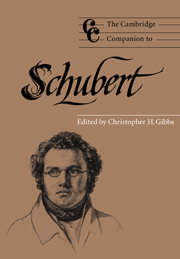Book contents
- Frontmatter
- Introduction: the elusive schubert
- Part I Contexts: musical, political, and cultural
- 1 Realism transformed: Franz Schubert and Vienna
- 2 “Poor Schubert”: images and legends of the composer
- 3 “The Passion for friendship”: music, cultivation, and identity in Schubert's circle
- 4 Schubert's inflections of Classical form
- 5 Schubert and his poets: issues and conundrums
- Part II Schuberts music: style and genre
- Part III Reception
- Notes
- Index
4 - Schubert's inflections of Classical form
from Part I - Contexts: musical, political, and cultural
Published online by Cambridge University Press: 28 September 2011
- Frontmatter
- Introduction: the elusive schubert
- Part I Contexts: musical, political, and cultural
- 1 Realism transformed: Franz Schubert and Vienna
- 2 “Poor Schubert”: images and legends of the composer
- 3 “The Passion for friendship”: music, cultivation, and identity in Schubert's circle
- 4 Schubert's inflections of Classical form
- 5 Schubert and his poets: issues and conundrums
- Part II Schuberts music: style and genre
- Part III Reception
- Notes
- Index
Summary
The mimetic elements of Gretchen am Spinnrade (D118) have always been easily identified, and they are amazingly specific: the right-hand sempre ligato represents the turning wheel; in the left, the tenor sempre staccato imitates the continuous clicking sound of the spinning, and the bass (particularly in measures 4 and 6) the occasional impulse that the spinner's foot must give to the pedal. These elements dominate the opening of Schubert's first acknowledged masterpiece of October 19, 1814 (see Ex. 4.1, measures 1–16). And every music student knows that the imitation gives the basic structure of the song at its climax: as Gretchen remembers Faust's kiss, the wheel ceases to spin, only to start up again as she returns to the contemplation of her sorrow and her despair.
Mimesis determines the song in other ways as well, one aspect already revealed in the first sixteen measures. First, however, we should remark the faulty declamation. The meaning of the opening lines demands accents on “hin” and “schwer.” However, my peace is gone, my heart is heavy, is Schubert's odd emphasis, which goes against the sense, as if another state of mind could be gone, some other organ heavy. But it makes a better sound: “Ruh” has a more beautiful and agreeable vowel for singing than “hin,” and it is clear that musical considerations take priority over meaning and prosody for Schubert, and they continue to do so until the end of his life.
- Type
- Chapter
- Information
- The Cambridge Companion to Schubert , pp. 72 - 98Publisher: Cambridge University PressPrint publication year: 1997
- 4
- Cited by



